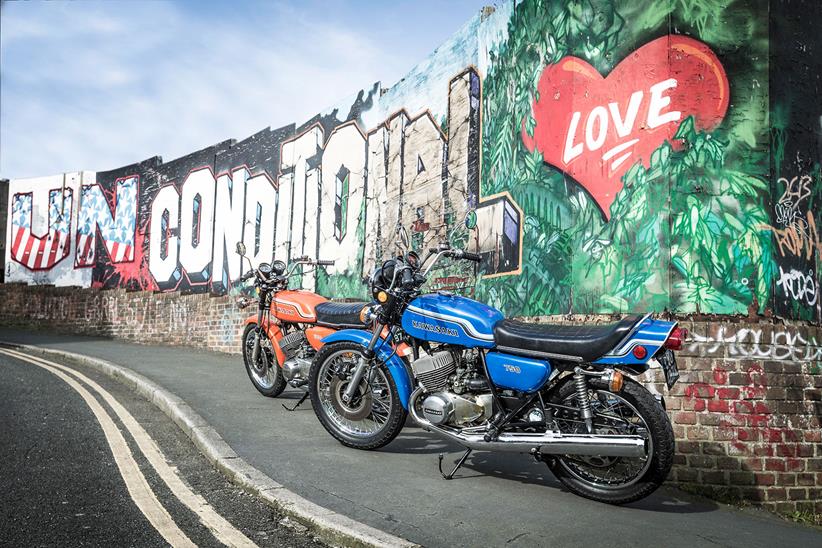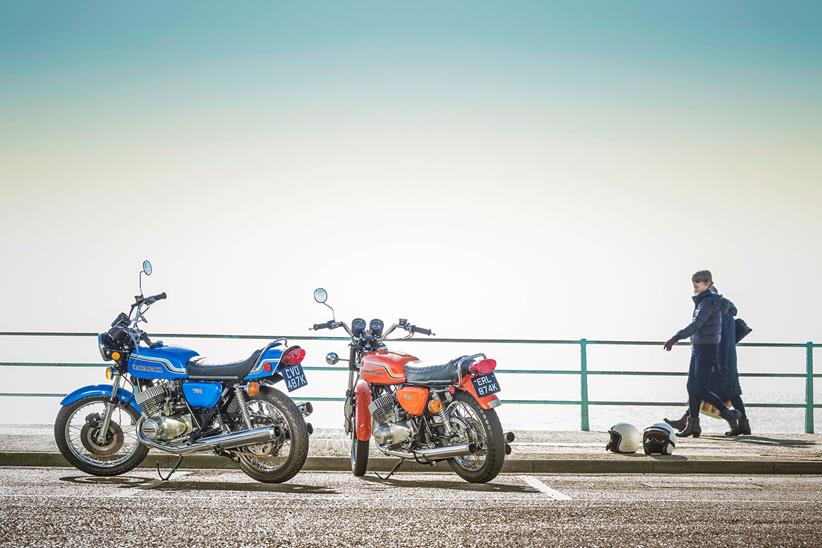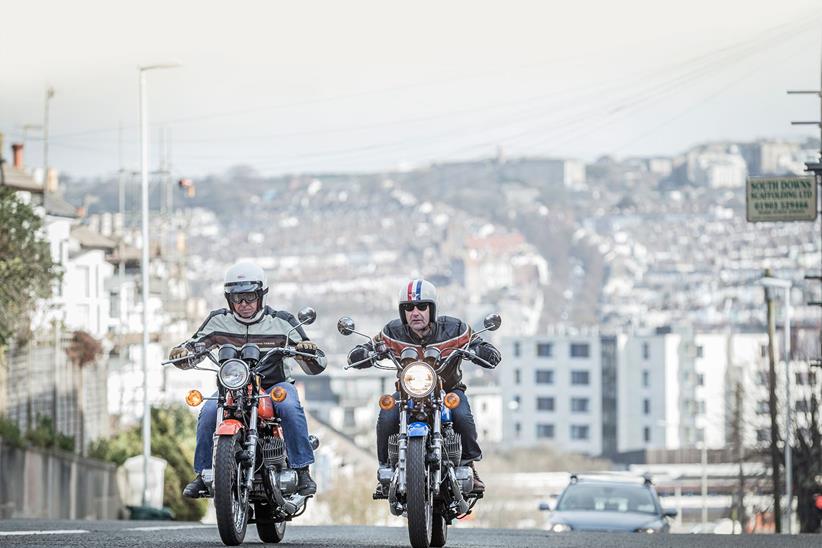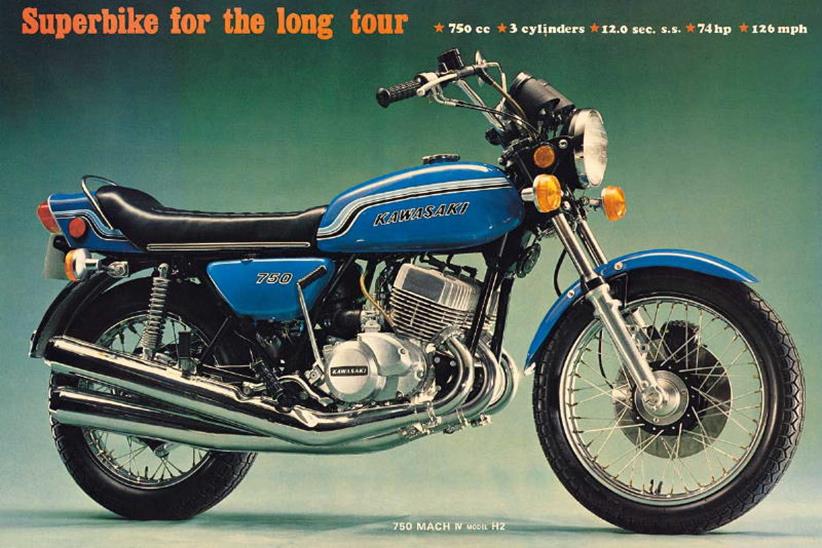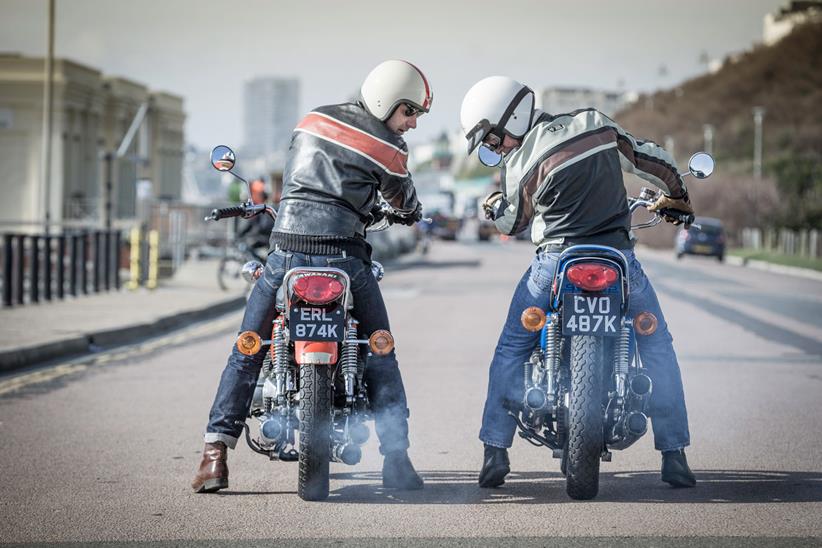'Evil, wicked, mean and nasty': the bikes that got Kawasaki hooked on evil
Long before Kawasaki had the psychotic 296bhp H2R, it was dabbling in antisocial behaviour with its two-stroke triples of the ’70s. The 750 H2 and 500 H1B share a reputation as the vandals of the roads – but riding them reveals they’re very different animals.
![]() loody yob.’ I could see it in the Police Community Support woman’s glare. Her brain was weighing the pros and cons of pulling me over, while I sat at a red light, the gleaming Kawasaki 750 H2 grumbling out more noise and hydrocarbons than a vehicle ever should nowadays.
loody yob.’ I could see it in the Police Community Support woman’s glare. Her brain was weighing the pros and cons of pulling me over, while I sat at a red light, the gleaming Kawasaki 750 H2 grumbling out more noise and hydrocarbons than a vehicle ever should nowadays.
I had my answer ready: “It’s completely and utterly stock officer. The Seventies were considerably more tolerant than we care to remember.”
But the lights changed. The moment passed. Relieved, I unleashed the hefty clutch and gave the big old stroker a dose of throttle to pull smartly past the bijou shops that lined the steep Brighton hill.
As the 1972 Kawa burst from its self-made smokescreen, the front wheel popped up by a good 18 inches. Whoops. Entirely involuntary, you see. But what the hell. These big old triples were never meant for polite company.
Revving away nearby, as Sundance to the 750’s Butch, sits an eye-searingly orange Kawasaki 500 H1B. The Pearl Candy Orange covering the tank, side panels and front and rear guards is, in itself, sufficiently outrageous to merit a traffic citation.
But once again, it’s entirely faithful to the great decade of glam. When I parked it outside a seafront cafe to use their facilities, I emerged to find a fellow biker forensically examining the 43-year-old machine. “Blimey, that’s a good rebuild,” he said. That’s no rebuild, my friend. Bar the odd nut and washer, the 9000-mile US-import triple is entirely as it left the shop.
![]()
Indeed, it carries a perfectly preserved reminder of how American biking culture has always been rather different to ours. In Britain in the Seventies, bikes carried stickers that warned: “Touch my ride and I’ll break your legs.” This machine still carries a decal on the top of its back light saying: ‘Warning. Protected by AMA. The American Motorcyclist Association will pay a reward of $200 if information leading to the arrest and conviction of any person involved in the theft of this motorcycle while it is owned by a member of the Association.’
Likewise, the 1972 H2, with only 12,000-odd miles on the odometer, stands mercifully unmolested by modifying fingers. The only evidence of wear and tear comprises some slight rubbing of the crinkle black on the front of the instrument binnacles, and a smudge of fuel-drip discoloration on the left-hand crankcase.
Both bikes belong to Martin Young, who had them imported from the States by the triples-guru Rick Brett. The H1 carried a Michigan plate prior to coming to the UK last year. Mr Brett had used it as his stateside summer rider. The H2 lived in Minnesota before being imported here two years ago. It had been a one-owner bike over there for years.
Evil, wicked, mean and nasty
Nowadays, the H2 is the star of the duo. If any classic bike grunts ‘badass’, it’s the 750-three. Legends about crazy power and suicidal handling stick to it like baked beans on a student-house saucepan. There are only two types of H2 rider – the quick and the dead. So went the old stories. The passage of time has gilded them with the patina of fact. Owning an H2 will do the same for your reputation as a 15-year stretch for armed robbery. The thing about the H2 in the Seventies and Eighties, though, is that hardly anyone in Britain saw one in the flesh, let alone rode one.
Kawasaki’s early-Seventies UK import arrangements were somewhat random, to say the least. So the numbers were never big for any of the early triples. For the biggest one, they were tiny. Only 113 H2s were officially brought into the UK in 1972. For all the versions over the 750’s four-year lifespan, only 563 came here.
![]()
By comparison, the H1 was a UK bestseller. In 1972 a total of some 160 H1Bs were imported. Of all the H1 versions, from 1969-76, around 1590 were brought in. Ironically, about 600 were the final, heavily-castrated type, the KH500 – shows what could happen when the big K finally got its dealership act together.
That comparative familiarity with the 500 has bred a degree of contempt. “Wow yeah, an H1… but what you really want is one of them H2s.” No British magazine in the day ever directly compared them back-to-back. So this is something of a first attempt at objective comparison.
Objective? Well, I do have to confess to a hefty dose of bias here. I’ve had H1s – mostly the comparatively sanitised ’74/’75 models – since the 1980s. Despite their many foibles, I wouldn’t be without one. Fact is, though, they are completely different beasts to H2s, belying their sibling good looks, similar badging and yen for antisocial behaviour – the all-seductive aura of candy-flake lethality.
There are many different ways to be antisocial (just ask the police). In America in 1969, the original white H1 was launched as the 500SS Mach III. The Yanks took SS to mean ‘Stoplight to Stoplight racer’ – specially built for urban hooliganism.
![]()
The H1 was Kawasaki’s first triple. It was launched with one single-minded aim: to cement the big-K’s reputation in riders’ minds as a no-compromise performance brand, with the fastest-accelerating bike that the world had ever seen.
Kawasaki called this secret endeavour Project N100. Make no mistake, they knew exactly what they were doing. And they did it. Mission accomplished (shock-horror headlines and a 12.8-second standing quarter were promptly achieved). The Japanese makers then began steadily civilising the bike over ensuing years by adding mid-range at the expense of top-end, handling at the cost of weight, and emissions-legality at the cost of free breathing.
But not by very much. Any H1 is a hard-rattlin’, smokin’ hoot. This B model offers a good compromise between most evil and least entertaining. Well, it’s got the newly-introduced front disc brake, anyway – even if it doesn’t have the wheelie-damping lengthened chassis of the following year’s model.
Twist your wrist and hold your breath
Whichever model you ride, don’t expect anything in the way of mid-range power. Getting the H1B smartly off the line involves thrashy high revving, yowling intake noise and a glut of blue smoke. Shrinking violets need not apply. Once you’ve wound it up to the magic 6000rpm mark, all the bike’s claimed 60 horses kick in. That’s not much by the standards of today, but it still feels like armageddon – thanks, not least, to the slump in power that preceded it. Yes, it’s a two-stroke, only worse. And better.
![]()
The H2 is a complete contrast. When it first emerged in 1972, riders expected it to be more of the same. It is indeed that – more straight-line power, and that’s it. Rather like a narwhal’s tooth, the H2 is one single characteristic, taken to the extreme of extreme.
But the manner in which it delivers its claimed 74bhp is completely different to the H1. The first clue to their relative power characteristics is revealed by their tachometers. The H1 redlines just short of 9000rpm, while the H2 hits the red-zone earlier, at 7250rpm.
As a Dutch H2 owner once told me, in his impeccable English: “This bike is like riding a wall of torque”. Indeed, the huge mid-range power feels far more like a four-stroke than a peaky, pipey two-cycle motor.
Jump on either of the bikes and your first task is to get accustomed to Kawasaki’s strange old habit of putting neutral at the bottom of the gearbox. There’s nothing quite as embarrassing as giving it a handful in front of a crowd, dropping the clutch, and moving forward not an inch. It’s a problem that can prove seriously dangerous at junctions.
With the H2, first impressions also include the bike’s considerable vibration. Some of these 750s’ cranks are so poorly balanced that it’s like holding on to a jackhammer. This one is comparatively civil. Open the taps and you are rewarded with a deep, guttural roar. The power delivery is so gloopily thick that it’s deceptive. You can promptly find yourself busting city speed limits or pulling an unplanned wheelie before you know it. In the first two gears on this particular bike, the throttle feels like it’s attached to a winch for raising the front tyre.
The H1B, by contrast, feels primitively flighty, thanks not least to the high, thin bars and the minimal switchgear. The basic feel is reinforced by this particular bike’s habit of topping out the forks with a clang. It’s a more visceral experience than the H2, like a nervous greyhound on amphetamines. It wants to make you do bad things. Why bog the engine about at less than six grand, when all the action is up in the howling zone?
Beware outbreaks of spite
Both bikes feel remarkably easy to ride in town. With your knees gripping the thin tanks, it’s a cinch to tip their skinny tyres into tight, urban corners and smoke away in a bellow of power. On fast, twisty A-roads, however, the bikes can suddenly justify their reputation for spitefulness – if you push your luck. The real problem is unpredictability. Most times, they will take a sharp bend or sweeping corner with beguiling alacrity. But on a day when the devil gets into them, they can decide to go into a buck-and-weave routine that has you heading for the nearest wall or hedge. Or into a nasty tank-slapper, despite standard-fitment steering dampers.
Holding either bike with the throttle wide open for any amount of time also means sorely tempting the gods of holed pistons, scored bores and thrown conrods. Today I’m not out to break world records, scrape footpegs or, heaven forbid, scratch the right-hand lower pipes on the tarmac. And for good reason – both these bikes are shod on their original K97 Dunlop Gold Seals. Their reputation was iffy in the Seventies. Four decades of gentle dilapidation won’t have helped.
![]()
But for roaring round backstreets and coastal drags, plus a pipe-clearing burst of speed between towns, both bikes feel perfect, in their different ways. Back in July 1972, America’s Motorcyclist Magazine summed up the bikes’ contrasting styles by concluding: ‘The 500 is almost as fast as the 750, but is trickier to ride because of minimal low-end grunt and peaky power. It does everything the 750 does at only fractionally lower levels of performance – offering incredible go power at an unreal low price [a measly £768 in those heady Stateside days].’
That price differential remains. Nowadays H1s are only mildly overpriced for what they are. You can get a fine example for between £5000 and £6000. Asking prices for H2s, by contrast, are stratospheric, not least because they have crossed the ‘investment bike’ threshold of £10k-plus. This means that potential buyers have to be very careful in these times. The gleaming chrome and paint of a restored H2 can hide a multitude of sins perpetrated over the decades by racers, backyard customisers, thrashers and thieves. With these old bruisers, ‘original’ is usually a relative matter.
Martin Young almost got burnt in his quest to find a good ’un. “I wanted as original an example as possible and was offered an early blue one, but with black barrels. I kept asking the vendor for the engine and frame numbers, which weren’t forthcoming. Then
I heard the engine was unstamped, so I pulled out of the deal.”
High prices, combined with dangerous reputations, make it tempting to keep a prized H2 only for rare forays on the road. However, a dog is not just for Christmas, and a Kawa triple is not just for the garage – unless you want it to turn into a permanent static-display object.
The importance of regular exercise
These bikes need constant fettling. They also need regular riding, otherwise the crankshaft oil seals will harden and fail. Compared with the £1000 cost of an engine rebuild, filling these thirsty bikes’ tanks seems a snip – even though an energetically-applied right wrist can send their fuel consumption plummeting to the low end of the 20mpg range.
Both Martin’s bikes are looking forward to having some summer miles put on them. The H2 had a winter’s worth of sleep to wipe from its eyes. The H1 had suffered an enforced layoff due to DVLA backlog processing NOVA import applications that stretched for months on end. The 500’s registration number only came through a week before our test.
So it wasn’t entirely surprising that the first ride of spring raised a couple of issues with both bikes. While hauling across town on the H2, the motor went momentarily fluffy. I thought a plug was oiling slightly, so tried to ride through the problem. Then it shot out two monumental backfires (I’d never heard a triple do that before in 30 years of ownership) and fired an exhaust baffle down the road. It then ran much better.
By the time I’d U-turned to retrieve the baffle, a car had run it over, leaving a squashed metallic sausage sitting wanly on the tarmac. The impact had at least knocked a lot of carbon out of the holes. Martin, being his characteristically affable self, shrugged his shoulders when I confessed what had happened, then said: “Don’t worry, it’s just a mechanical incident. Would have happened whoever was on it.”
Martin subsequently emailed a picture of a fully revived baffle, thanks to an hour’s work with a hammer and a rounded mandrel. Phew. Those baffles are made from pure unobtanium. Replacements can cost hundreds – if you can find one.
The H1 went rather off colour after a lot of roaring up and down the same road for the photographer. There was nothing perceptible, just a dose of the grumps. It revived completely after being left to cool for five minutes.
Is ownership worth all the bother? Good lord yes. Once fully sorted, and ridden with an appropriate blend of caution and craziness, these big triples provide miles of unparalleled fun.
Just sit these two beauties together on a side-street or by the seaside, and their gleaming candy-flake shines almost as bright as their aura of danger.
Fend off the admiring crowds, pull away like some Seventies road-god and you will know that, while the reality might not quite match the fearsome reputation, it’s dammit near enough to put the widest grin on any midlife urban hooligan’s gob.
![]()
Words: John Naish Pics: Gary Freeman
